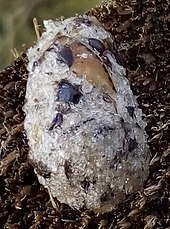
Back كرة شعر Arabic Egagrópila AST Egagròpila Catalan Vývržek Czech Gewölle German Vomaĵo (ornitologio) Esperanto Egagrópila Spanish Egagropila Basque ریمه Persian Oksennuspallo Finnish



A pellet, in ornithology, is the mass of undigested parts of a bird's food that some bird species occasionally regurgitate. The contents of a bird's pellet depend on its diet, but can include the exoskeletons of insects, indigestible plant matter, bones, fur, feathers, bills, claws, and teeth. In falconry, the pellet is called a casting.
The passing of pellets allows a bird to remove indigestible material from its proventriculus, or glandular stomach. In birds of prey, the regurgitation of pellets serves the bird's health in another way, by "scouring" parts of the digestive tract, including the gullet. Pellets are formed within six to ten hours of a meal in the bird's gizzard (muscular stomach).
Ornithologists may collect one species' pellets over time to analyze the seasonal variation in its eating habits. One advantage of collecting pellets is that it allows for the determination of diet without the killing and dissection of the bird. Pellets are found in different locations, depending on the species. In general, these are roosting and nesting sites: for most hawks and owls, under coniferous trees; for barn owls, at the bases of cliffs or in barns and silos; for yet other species of owls, at their burrows or in marsh and field grasses.[1]

Hawk and owl pellets are grey or brown, and range in shape from spherical to oblong or plug-shaped. In large birds, they are one to two inches long, and in songbirds, about half an inch. Many other species produce pellets, including grebes, herons, cormorants, gulls, terns, kingfishers, crows, jays, dippers, shrikes, swallows, and most shorebirds.
Ornithologists examining pellets have discovered unusual items in them—even bird bands that were once attached to a smaller species that was consumed by the predator bird. In the United States, screech owl pellets have contained bands from a tufted titmouse, black-capped chickadee, and American goldfinch. In 1966, a golden eagle pellet in Oregon was found to contain a band placed on an American wigeon four months earlier, and 1,600 km (990 mi) away in southern California.[1]
The hair, bones and other body parts (such as limbs, skin fragments, and even faeces) of rodents found in owl pellets may carry viable rodent viruses and bacteria. For this reason, they are sometimes sterilized before study. Smith et al. described two pellet-borne outbreaks of Salmonella typhimurium in schools where unsterile pellets were dissected.[2] Rodents tend to avoid owl pellets, apparently due to their infective potential.[3]
- ^ a b Terres, John. K. The Audubon Society Encyclopedia of North American Birds, New York: Alfred A. Knopf, 1980. ISBN 0-394-46651-9
- ^ Smith, KE; Anderson, F; Medus, C; Leano, F; Adams, J (2005). "Outbreaks of salmonellosis at elementary schools associated with dissection of owl pellets". Vector-Borne and Zoonotic Diseases. 5 (2): 133–136. doi:10.1089/vbz.2005.5.133. PMID 16011429.
- ^ Sike T, Rózsa L 2006. Owl pellet avoidance in yellow-necked field mice Apodemus flavicollis and house mice Mus musculus. Acta Zoologica Academiae Scientiarum Hungaricae, 52, 77–80.